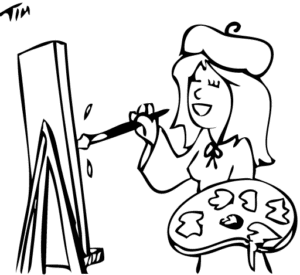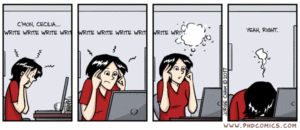Hello everyone,
A friend of mine, once told me and I quote “Writing a paper is like drawing. You start by defining sections you need and describing what you need in each section and adding detail until you’ve got your text”.

So, for today’s blog I thought about sharing my experience of writing a paper for a conference. We all know what it is like to write a report or an essay and for most of us, it is a big ordeal. However, as a PhD student I have really begun to realise the importance of writing. A key skill to being a good researcher, is being able to convey your work in the best possible light and in the most articulate form. While you may think that the main part of research are the results, conveying the process of arriving at the results in a concise manner and expressing why we think the results are important and different is key. Unlike a talk or presentation, our writing has to be engaging enough to keep the reader of the paper interested.
A good portion of my time is spent writing yearly short reports, papers for conferences and journals, so I thought I would write about what I have learnt from the process while sharing some funny moments along the way.
- Reality versus Expectations on the time to complete
When I first started writing the paper in January of this year, I kept an optimistic estimate of two months to write everything up. In fact it is already June and I am still refining my paper with new experiments and results! For now, I have just submitted my final draft to the conference, and have to wait for the review. Depending on the outcome of the review, one of three things could happen:- A highly unlikely scenario: the paper was so great it brought tears to every one reading it and there are no major corrections
- The paper gets accepted but the comments and suggestions have to be worked upon to make it ready for the final version
- The paper gets rejected and I spend the initial days contemplating on my life choices and then I pick myself up and work towards the next conference. Throughout the year “prospective” conferences deadlines appear every few months or so and there are plenty of opportunities to re-send my paper to any of these if it gets rejected.
- Missing the occasional good weather
I am not sure, but I have always felt that we have warm sunny days when either I’m having exams or working towards a deadline! Manchester was fortunate enough to have some sunny days this year and I remember being inside the lab formulating a million reasons in my mind to be outside but unfortunately I could not. Sure, I could take my laptop and write outside, but then where is the fun in that? - Writer’s block
I never knew what this meant until I decided to write the introduction section of my paper. There were days that the backspace button of my key board received so much attention it was feeling overwhelmed. It was in times like these, I decided that a friendly chat with friends or supervisors would help me get much needed inspiration.
- Writing a related work section: The key to differentiating your work from others is to be able to place your work in the context of what has already been done. So the “related work” section of the paper is my least favourite to write because I have to go through the pain of reminding myself about all the past papers that I have read. I have to critically analyse each paper for producing just two to three sentences per paper. I used tools like Evernote to try to maintain online notes of the papers I have read. On a side note, I have around 150 notes in my account. I don’t know if that is a good enough number to boost my confidence!
- Trying to reach the page limit
Typically conference papers are 10-15 pages long. Some are single column format papers while others are double column. It is important to not exceed the page limit despite the wealth of information you may have. It is equally necessary that you express data in a form which is easy to comprehend and devoid of long heady sentences. In such cases, graphs are your best friends! For my paper, I had a plan of what each section was supposed to convey to the reader and I made a rough outline of its contents. - Feelings of procrastination and pessimism
Thoughts such as “Is my paper any good?” or “Will it even be accepted?” or “I don’t feel like writing today” were definitely popping up in my head every now and then, but as my supervisor says, “Sending your paper to a conference is like getting a lottery ticket. You get the ticket and wait till you know the results. If you lose, you buy another ticket” 🙂
In moments like these, I decided to take a short break from writing and take a walk to clear up my thoughts. - Chocolate bars versus Apple pies
I find the most interesting part of the paper is creating pictorial representations. It is basically like artwork for your paper. Having good graphs (bar vs. pie charts) help with the first impression of the paper. So picking the right chart type to express ideas/results, showcase the amount of effort and thought you have put to make the paper interesting for the reader. I found Python’s matplotlib to be quite handy to make graphs. But there other options like inkscape, pgfplots that have been suggested by others. - Asking people to review
The final bit of my paper writing exercise was getting my content peer-reviewed. Usually, students get their PhD thesis chapters reviewed by colleagues in the lab. This is quite helpful because I got inputs on my writing style, the structure of my paper and the occasional grammatical errors.
Finally, I have submitted my paper and I will keep my fingers crossed that it will get accepted. Until then, see you in my next blog!
Cheers,
Crefeda

Nice post. Thanks for sharing your experience at Manchester
Hi,
Thanks! Glad you liked the post.
BW,
Crefeda